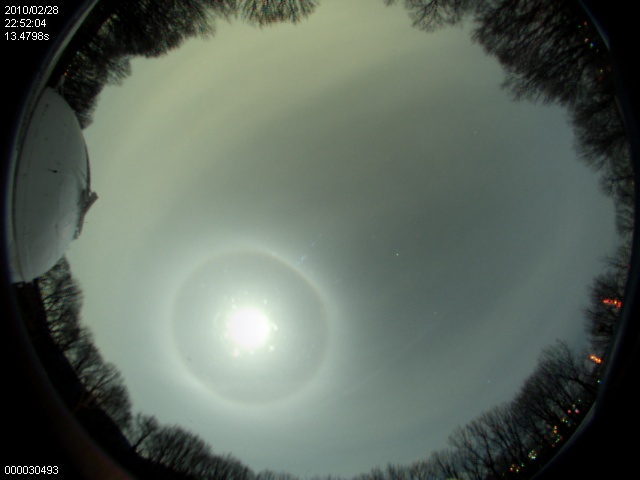On nights when a bright moon is seen through passing cirrostratus clouds, one might have the opportunity to witness a moon halo, just like the one above captured by Dyer Observatory’s All-Sky camera. The halo measures 22° from the center to the bright inside edge, about twice the width of a fist at arm’s length, and is caused by light reflecting and refracting through hexagonal ice crystals. Halos are often thought to be indicators of future rain systems, but there is no direct connection.
Careful inspection of the halo will reveal that the inner edge has a slight red hue. Not only is the light of the moon reflected to form the circular halo but it is also broken up into its component colors, just like light passing through a prism. The spreading, or dispersion, of the colors from these types of ice crystals is subtle. When the light rays from the countless number of crystals overlap, all of the various colors are washed out as they form white light, except for the red at the inner edge. The blue/violet hue that one might expect to see at the outer edge is not visible because the halo fades the farther you look from the center and the faint blue hue of the sky itself helps to wash out any residual color.
It is also possible to observe halos around the Sun; however, great care must be taken to obscure the Sun so that eye damage doesn’t occur. In the above image, the halo looks a bit squashed just like the Seyfert Telescope dome (left side). This is a result of the distortion created by the fisheye lens of the camera.
<- Previous April 23, 2020 Next ->
Tucked up among the wooded hilltops of northern Brentwood, Vanderbilt Dyer Observatory is considered by many to be a hidden treasure of the area. Visitors to our satellite campus not only learn about some of the cutting-edge discoveries and science in astronomy but they also get a dose of nature, history, and many other things while here. Over the years, we at Dyer Observatory have made the preservation of our facility and grounds a key mission. Preservation not only entails things such as maintaining our telescopes — it also includes keeping a record of days passed. Since 1953, we have amassed a number of interesting images, pieces of equipment, and ephemera. Every day tends to bring new surprises. In continuing our tradition of public education and outreach, Stellar Finds regularly provides an image and description of the diverse paraphernalia associated with Vanderbilt Dyer Observatory and the history of astronomy at Vanderbilt University.
